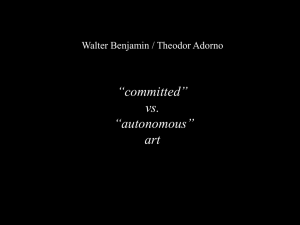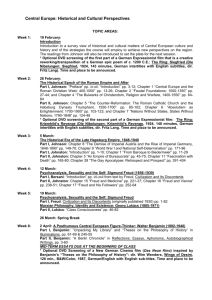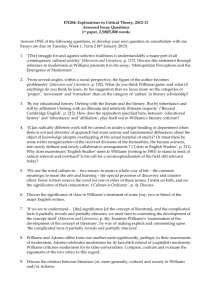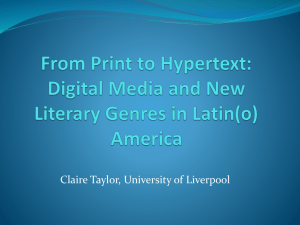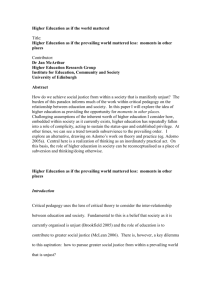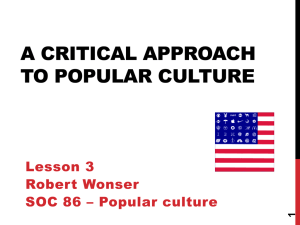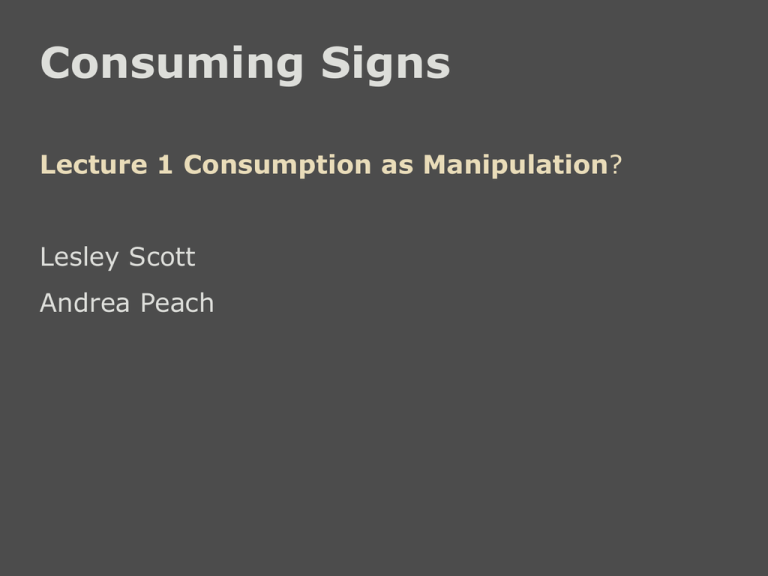
Consuming Signs
Lecture 1 Consumption as Manipulation?
Lesley Scott
Andrea Peach
consuming involves the using
or using-up of something
browsing
touching
listening
time
shopping
owning
acquiring
eating
looking
The act of consuming expresses
(consciously or unconsciously)
a wider set of cultural and ideological systems
Consuming within a free
market place is about
personal choice …
… access to goods is
limited only by the
consumer’s ability to
pay for them …
Consumer culture is based on a constant
expansion of demand
Western economy is fuelled by insatiable desire
to produce more wealth, acquire more power
and consume more goods
Tracey Emin
I’ve got it all 2000
Consuming Signs
Consumption becomes
the leading device
through which
individuals construct
their identities
Cultural Consumption as Manipulation?
If consuming requires making individual choices …
Is consumption an expression of personal
freedom and individualism? ….
Or is it a manipulation of needs and wants by
dominant institutions?
Are we Passive or Active consumers?
Theodor Adorno
(1903-1969)
The Frankfurt School
The Culture Industry
Adorno believed that
consumption was being
used as a vehicle for
pacification, coercion
and manipulation of the
masses
As soon as the film begins, it
is quite clear how it will end,
and who will be rewarded,
punished, or forgotten. In
light of music [popular
music], once the trained ear
has heard the first notes of
the hit song, it can guess
what is coming and feel
flattered when it does come.
Theodor Adorno
Dialectic of Enlightenment
1947
A key feature of the culture industry’s products is
standardisation coupled with a pseudo-individualisation
The Culture Industry is a product of capitalism
generates false needs. These needs work as a
means of social control.
This is because work under capitalism is dull and
boring, leaving little energy or imagination for real
escape
The culture industry makes people aspire to the false fulfillment
of wish dreams such as wealth, adventure, passion, love, power
and sensationalism
Problems with Adorno?
Presumes consumer to be a ‘cultural dope’ a mindless victim of the consumer industry
Imposes his own ‘elitist tastes’ on a culture
he doesn’t understand and doesn’t want to
understand (popular culture)
Does not allow for any critical engagement or
debate with cultural consumption …
which brings us on to Baudrillard …
“The fact that the worker performs acts of
consumption in his own interest, and not to
please the Capitalist, is something entirely
irrelevant to the matter”
Karl Marx
‘forced purchases based on inflicted desires’
R.J. Lane
From production to consumption, from economic
to social, from receiving to transmitting, from
silence to communication, from passive to active
consumption
The Consumer Society: myths and
structures
Jean Baudrillard. 1970
“The circulation, purchase, sale, appropriation of
differentiated goods and signs/objects today
constitute our language, our code, the code by
which the entire society communicates and
converses”
Veblen (1989) and Baudrillard
(1972)
Objects never exhaust
themselves in the function
they serve …….they take
on their signification of
prestige…they no longer
‘designate’ the world, but
rather the being and social
rank of their possessor
For a Critique of the Political
Economy of the Sign. 1972
Active consumption
• The consumer is using the goods to create and
communicate a social identity, membership of
one or more social groups. Thus products
may be used to signify maleness as well as
middle-classness. The consumer is also using
the goods to signify a place relative to other
social groups
How active?
• For Adorno, the consumer remains the
passive participant in an authoritative
commercial and social order, subject to the
dictates of media and advertising, a
recipient with minimal intervention in a
prescribed set of practices
• Baudrillard
The Culture Industry
“a window into the
real world of the
woman”
Are we Passive or Active Consumers?
Is consumption an expression
of personal freedom and
power? ….
Or is it a manipulation of
needs and wants by dominant
institutions?
Signs of resistance
“commercial sites of intensified femininity”
“So familiar are these that they enter our unconscious
producing desires and pleasures …even when we might not
want them to”
“what is going on when oral sex and the quality of
orgasm are the cover stories in magazines read by
girls as young as thirteen”
A better way of ‘doing’ sex
education …magazines
have broken the grip of
clinical terminology
“The readers of these
magazines ..know far more
about coercive sex, sexual
exploitation, rape and incest
than previous generations”
Stevi Jackson – female sexuality continues to be
organised around fashion beauty and personal
appearance as if for male consumption
Sassy
An alternative feminism?
“What they are rejecting is a particular
image of the feminist which they associate
either with an older generation or with a
or with a stereotypically unfeminine
image”
By “doing gender” in an exaggerated and
ironic way…(it can) give girls room to
breathe; it gives them space to explore
new emotional ground on their own terms
Angela McRobbie.
I
“Female
assertiveness, being
in control and
enjoying sex, are
now recognised as
entitlements”
Irony and pastiche
“There is an
assumption that we
are not so naïve as to
imagine that these
captions are not a
parody of vulgar or
downmarket
literature”
Or
• A commodification of femininity which
still views beauty and the thin body as
the feminine ideal
• Cynical marketing of a product which
conceives of women as interested in
little more than appearance, shopping,
fame and sex
• Establishing a damaging set of norms
for young teenage girls
• Making money on the basis that “sex
sells”
Are we Passive or Active Consumers?
Is consumption an expression
of personal freedom and
power? ….
Or is it a manipulation of
needs and wants by dominant
institutions?

